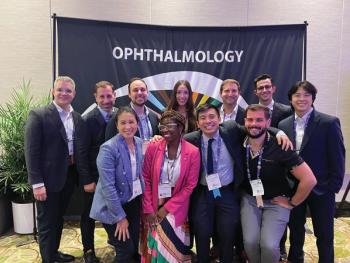
AAO practice patterns offers ‘awareness’ to proper AMD treatment
The American Academy of Ophthalmology’s Preferred Practice Pattern on Age-Related Macular Degeneration “are based on the best available scientific data as interpreted by panels of knowledgeable health professionals.” These patterns offer solid clinical guidelines for treating and counseling AMD patients.
By Michelle Dalton, ELS
Since the introduction of the anti-vascular endothelial growth factor (anti-VEGF) intravitreal drugs, these therapies have become the mainstay of treatment for neovascular age-related macular degeneration (AMD).
The American Academy of Ophthalmology’s (AAO) Preferred Practice Pattern on Age-Related Macular Degeneration “are based on the best available scientific data as interpreted by panels of knowledgeable health professionals.”1 The recent version was updated in 2015. Here are its main points:
The AAO notes that while an estimated 80% of patients with AMD have non-neovascular or atrophic AMD, the neovascular form is responsible for nearly 90% of the severe central visual acuity loss associated with AMD. AMD is characterized by the presence of at least intermediate-size drusen (63 µm or larger), retinal pigment epithelium (RPE) abnormalities (such as hypopigmentation or hyperpigmentation), reticular pseudodrusen, among others.
AAO uses a combination of the Age-Related Eye Disease Study (AREDS) and a separate clinical classification to define the stages of AMD since current treatment recommendations also follow those classifications.
Risk factors of AMD
Primary risk factors for the development of advanced AMD include increasing age, ethnicity, and genetic factors. The leading modifiable risk factor for AMD is cigarette smoking, which has been “consistently identified in numerous studies.”
Clinicians should advise smoking cessation is strongly recommended when counseling patients who have AMD or are at risk for AMD. (Low systemic levels of antioxidants may also be modifiable risk factors.) Numerous studies have identified an association between dietary fat and advanced AMD; a diet high in foods rich in omega-3 long-chain polyunsaturated fatty acids (such as fish) are recommended.
A meta-analysis of 10 studies has found the use of aspirin is not associated with an increased risk of AMD. Therefore, patients on aspirin therapy should continue to use it as prescribed.
Antioxidant vitamin and mineral supplementation–as used in the AREDS and AREDS2 trialsÖshould be considered in patients with intermediate or advanced AMD. However, there is no evidence to support use of those supplements in people with intermediate or less AMD.
In the AREDS study, people who reported the highest omega-3 intake (not in supplement form) were 30% less likely to develop advanced AMD after 12 years. However, AREDS2 failed to demonstrate a benefit from the use of DHA and EPA as oral supplements, reinforcing that non-supplement form may be best.
AREDS2 formula
The AREDS2 formula replaced beta-carotene with lutein/zeaxanthin to decrease the risk of lung cancer in patients with AMD who are current smokers.
As with many ocular disorders, early detection and prompt treatment improves the visual outcome. There is evidence to suggest using the AREDS2 supplement reduces the progression to advanced AMD in the fellow eye.
Fundus angiography and optical coherence tomography (OCT) are useful diagnostic tools in clinical practice to detect new or recurrent neovascular disease activity and guide treatment.
The AAO notes intravitreal injection therapy using the anti-VEGF agents (aflibercept, bevacizumab, and ranibizumab) is “the most effective way to manage neovascular AMD and represents the first line of treatment.”1 However, the AAO also added intravitreal anti-VEGF therapy is well tolerated and “rarely” associated with serious adverse events (that can include infectious endophthalmitis or retinal detachment).
Patient population
As its name suggests, patients with AMD are typically older (50 years or older) and may present with or without visual symptoms. However, AAO said clinicians should consider the possibility of other hereditary macular dystrophies in patients under 50 years of age who have clinical features that resemble AMD.
The 1.75 million people affected by advanced AMD in at least one eye is expected to increase to nearly 3 million by year 2020. The use of anti-VEGF agents likely will reduce the odds of legal blindness from neovascular AMD “and could theoretically reduce the rate of legal blindness by up to 70% over 2 years.”
Unfortunately, long-term follow-up studies on patients enrolled in clinical trials suggest that a majority of visual gains are lost in 67% of patients after 7 years. Use of the AREDS formulation “in an otherwise well-nourished population” in intermediate AMD has been demonstrated to reduce the progression toward more advanced stages of AMD by about 25% at 5 years.
Prevalence and age
AMD is responsible for an estimated 46% of cases of severe visual loss (considered 20/200 or worse). The prevalence, incidence, and progression of AMD and most associated features increase with age.
Prevalence also varies by ethnicity–in the Beaver Dam Eye Study (which evaluated a primarily Caucasian population), the prevalence of AMD was less than 10% in those between ages of 43 and 54, but more than tripled in patients aged 75 to 85 years old.
The Los Angeles Latino Eye Study found the prevalence of advanced AMD increased from 0% in people between the ages of 40 and 49 to just 8.5% in those more than 80 years old. Likewise, the Proyecto Vision Evaluation and Research of Hispanic people in Arizona found the prevalence of advanced AMD increased from 0.1% in people between the ages of 50 and 59 to 4.3% in those aged 80 and older.
Three other studies–the Barbados Eye Study, the Baltimore Eye Study, and the Macular Photocoagulation Study–also suggest that late stages of AMD are more common among Caucasians.
Debate over genetics
There remains debate about the role of genetics in developing AMD. Several studies have identified a strong association of complement factor H Y402H polymorphism with a higher risk of AMD.
The ARMS2/HtrA1 genes are in close linkage disequilibrium and are also associated with AMD. Other studies have suggested variants in hepatic lipase (LIPC) gene and the rs3775291 variant in the toll-like receptor 3 (TLR3) gene.
However, an analysis of the AREDS population that included an additional 526 AREDS subjects found that genetic testing does not provide benefits in managing nutritional supplementation. Waist/hip ratios in men also are considered a risk factor.
References:
1. American Academy of Ophthalmology Retina/Vitreous Panel. Preferred Practice Pattern Guidelines. Age-Related Macular Degeneration. San Francisco, CA: American Academy of Ophthalmology; 2015. Available at: www.aao.org/ppp
Newsletter
Keep your retina practice on the forefront—subscribe for expert analysis and emerging trends in retinal disease management.












































